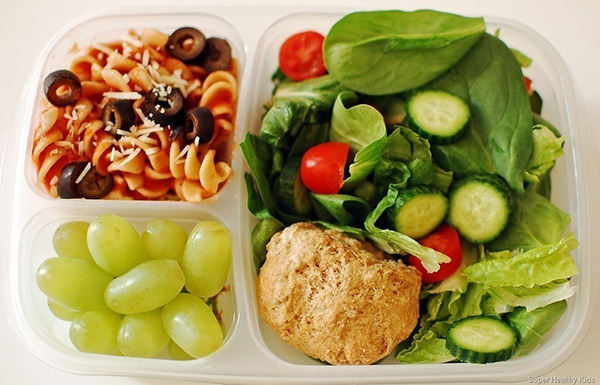
Labor Day has passed and summer time is coming to an end. We all know what that means – it’s the start of the back to school season. So parents are now busy rushing around picking up last minute school supplies but they should also be concentrating on something that I believe is way more important and will absolutely have a much larger impact on their child’s academic achievement and that is their diet. This is a transitional time of year and also the perfect opportunity to step back and reassess your child’s diet to see if they are getting the proper food and nutrients they need to achieve peak performance and the level of concentration they need to help with their school studies. At FIT we believe that it is vital for all parents to become actively involved in their child’s diet, especially while preparing that all important lunch box. It’s all about making better choices and substituting the typical high carb, low nutrient foods with what we refer to as the “brain foods”. These are the healthy nutrient dense foods that will help supply your child’s brain with the energy it needs to concentrate.
 The average American lunch, especially while eaten at school, is substandard to say the least. With childhood obesity at epidemic levels, it’s no wonder that recent surveys of diet in the United States have shown that 25 percent of school aged children get one serving or less of vegetables per day, and only 50 percent of school-aged children get one serving of fruit per day. The recommended daily allowance for fruits and vegetables for school age children and adults is 6 to 9 servings per day—much higher than what kids are actually eating! Obesity in our school age population is rising at unprecedented rates and a large part of that problem stems from children eating foods like sodas, refined foods, processed foods, junk foods and fried foods. These foods are low in nutrients and high in sugars and calories, which ruin immune function, cause chronic inflammation and pack on the pounds.
The average American lunch, especially while eaten at school, is substandard to say the least. With childhood obesity at epidemic levels, it’s no wonder that recent surveys of diet in the United States have shown that 25 percent of school aged children get one serving or less of vegetables per day, and only 50 percent of school-aged children get one serving of fruit per day. The recommended daily allowance for fruits and vegetables for school age children and adults is 6 to 9 servings per day—much higher than what kids are actually eating! Obesity in our school age population is rising at unprecedented rates and a large part of that problem stems from children eating foods like sodas, refined foods, processed foods, junk foods and fried foods. These foods are low in nutrients and high in sugars and calories, which ruin immune function, cause chronic inflammation and pack on the pounds.
It is obvious that the best way to combat obesity is to change a child’s diet. At first this may seem a daunting task but it is actually very easy if you employ a few simple steps. The best way to start this is to get your children excited around eating a whole foods diet that has a great balance of fruits, vegetables, whole grains, nuts and seeds, beans and legumes. These are the foods that are high in vitamins, nutrients, including phytonutrients, fiber, proteins and healthy fats. Lean meats, chicken, and fish are good choices for proteins. Another key to changing children’s diets is to change the options of the foods they can choose from on a daily basis. Change the snacks that they are accustomed to eating. Remove the junk foods from their lunches and in between meals and replace them with the healthier options. If you stop bringing junk food in the house they will automatically create the habit of eating better with the food that is available in the house. Fruits, vegetables and nuts are great snacks for children especially in the wake of the obesity epidemic that our country is facing.
Eating a whole food, nutrient dense diet with fruits, vegetables and healthy proteins has been proven to increase concentration and improve focus throughout the day. It also helps strengthen immune function which means less sick days at school. This diet also has been shown to increase athletic performance, focus and concentration, and decreases the exacerbation of chronic diseases. So when choosing meals and snacks for your children, always let nutritional dense whole foods be your guide. Of course, parents should also remember that children mimic what their parents eat and if they see you eating healthier they will too.

So, the preparation of that all-important “lunch box” should be a labor of love and not a chore. A suggestion to make this easier on parents is to plan a week’s worth of lunches at a time. It’s a great idea to have several different “go to” meals that can be easily prepared. This variation will not bore your child with daily repetition. Of course it is also very important to listen to your child and get their feedback to see if they are enjoying and eating all of their lunch. There are so many good websites I have recommended my patients go to get healthy recipes that you can experiment with. Here is one excellent site you may want to investigate that gives you the ability to “build” your own recipes according to your individual preferences.
And there you have it. Parents don’t have to be extra fancy when preparing these lunches — just keep it simple and delicious. Concentrate on using the most nutritional dense foods with very little reliance on processed items. Remember to use enough variety to increase the chances that it all gets eaten! I also feel it is most important to have honest discussions with your child to find out what they like and do not like. If they don’t like how it tastes, they won’t eat it. With all of the nutritious recipes available, there is no reason why a healthy lunch can’t be absolutely delicious. Experiment and enjoy the search together with your children and when 5 healthy and delicious lunches are agreed upon, you have Monday through Friday set which can then be repeated weekly, added to or modified. Enjoy the process and get your child involved so they learn about nutrition and healthy choices along the way.
You and your child will both be happy and healthy. Everyone wins!



